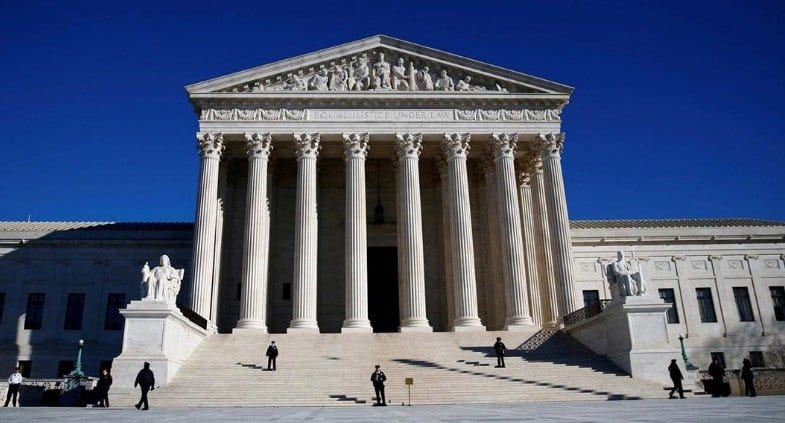
In a pivotal moment for American immigration policy, the Supreme Court is hearing arguments today in what could be its most consequential case of the year.
At stake is President Donald Trump’s controversial executive order challenging the longstanding interpretation of the 14th Amendment’s citizenship clause—a constitutional provision that has guaranteed automatic citizenship to virtually all babies born on U.S. soil for over a century.
The Battle Over America’s Birthright
The case stems from Trump’s day-one executive order in January 2025, which directed government agencies to deny citizenship to children born in the United States unless at least one parent is a citizen or lawful permanent resident. This dramatic policy shift has ignited fierce debate about constitutional interpretation, presidential power, and the future of American identity.
“This isn’t just about immigration policy—it’s about who we are as a nation and how we define belonging in America,” says constitutional scholar Maria Hernandez, whom I spoke with yesterday. “The Court’s decision could reshape our understanding of citizenship for generations.”
The stakes couldn’t be higher. Lower courts have already blocked Trump’s order, with judges appointed by both Republican and Democratic presidents ruling it likely unconstitutional. But the administration has appealed to the Supreme Court, arguing that federal judges shouldn’t have the power to completely pause presidential policies while they’re being challenged.
A Constitutional Showdown
At the heart of this dispute is the 14th Amendment’s citizenship clause, which states: “All persons born or naturalized in the United States, and subject to the jurisdiction thereof, are citizens of the United States and of the State wherein they reside.”
For more than 125 years, this language has been interpreted to grant citizenship to virtually everyone born on American soil. In 1898, the Supreme Court affirmed this understanding in United States v. Wong Kim Ark, ruling that a man born in the U.S. to Chinese parents was indeed a citizen.
But Trump’s administration argues that the phrase “subject to the jurisdiction thereof” excludes children of parents who aren’t citizens or permanent residents. They claim the amendment was primarily intended to grant citizenship to formerly enslaved people after the Civil War—not to children of immigrants who entered the country without authorization or who are here temporarily.
I remember covering a similar debate during Trump’s first term, when he floated the idea of ending birthright citizenship through executive action. Legal scholars were skeptical then, and many remain so now.
The Court’s Narrow Focus
Interestingly, the Justice Department seems to recognize the uphill battle they face on the constitutional merits. According to NPR’s Nina Totenberg, they’ve asked the Court to focus on a more technical question: whether federal district court judges have the power to block enforcement of Trump’s order nationwide.
“If Justice Roberts and the United States Supreme Court do not fix this toxic and unprecedented situation IMMEDIATELY, our Country is in very serious trouble!” Trump wrote on Truth Social, referring to nationwide injunctions that have stalled many of his policies.
The administration wants the Court to narrow these injunctions so Trump’s citizenship policy can apply as widely as possible until there’s a final determination about its constitutionality.
The Human Impact
Lost in the legal wrangling are the real people affected by this policy. The lawsuits challenging Trump’s order were filed by expectant parents, immigrant rights groups, and 22 state attorneys general. The pregnant mothers include immigrants who are not in the country legally, or who have pending asylum claims, temporary protected status, or student visas.
A recent NPR/Ipsos poll found that a majority of Americans oppose ending birthright citizenship, highlighting the controversial nature of Trump’s move.
The Migration Policy Institute notes that “birth tourism”—a phenomenon Trump cites as justification for his policy—is relatively rare. Only about 9,000 of the nation’s 3.6 million annual births are to foreign mothers who don’t live in the country. More targeted measures like visa enforcement would better address this issue, the institute suggests.
Even more striking, a joint analysis from the institute and Penn State’s Population Research Institute concluded that Trump’s executive order would actually increase, not reduce, the size of the nation’s unauthorized population.
Beyond Birthright: The Broader Agenda
This case arrives as House Republicans work to advance Trump’s self-described “big beautiful bill”—a sweeping package of tax, immigration, and social policy changes that faces its own internal divisions.
The bill would extend Trump’s 2017 tax cuts, eliminate taxes on tips and overtime, and make significant cuts to Medicaid and food assistance programs. But House Speaker Mike Johnson must navigate tensions within his own party, particularly from the Freedom Caucus, which argues the bill doesn’t go far enough in reducing deficits.
The Congressional Budget Office estimates that at least 8.6 million people enrolled in Medicaid could lose coverage due to changes in the House bill—another indication of the far-reaching consequences of Trump’s second-term agenda.
What Comes Next
The Supreme Court is expected to issue its decision on the birthright citizenship case by the end of June or early July. If the justices side with Trump and limit the nationwide injunctions, there could be different citizenship rules for different people until the Court eventually decides whether the policy itself is constitutional.
Such a ruling would not only impact birthright citizenship but could make it harder for judges to pause other Trump initiatives—potentially giving the administration greater latitude to implement controversial policies while legal challenges work their way through the courts.
As one legal observer put it to me: “This isn’t just about babies born to immigrants. It’s about the balance of power between the executive branch and the judiciary. The Court’s ruling could reshape that relationship for decades to come.”
